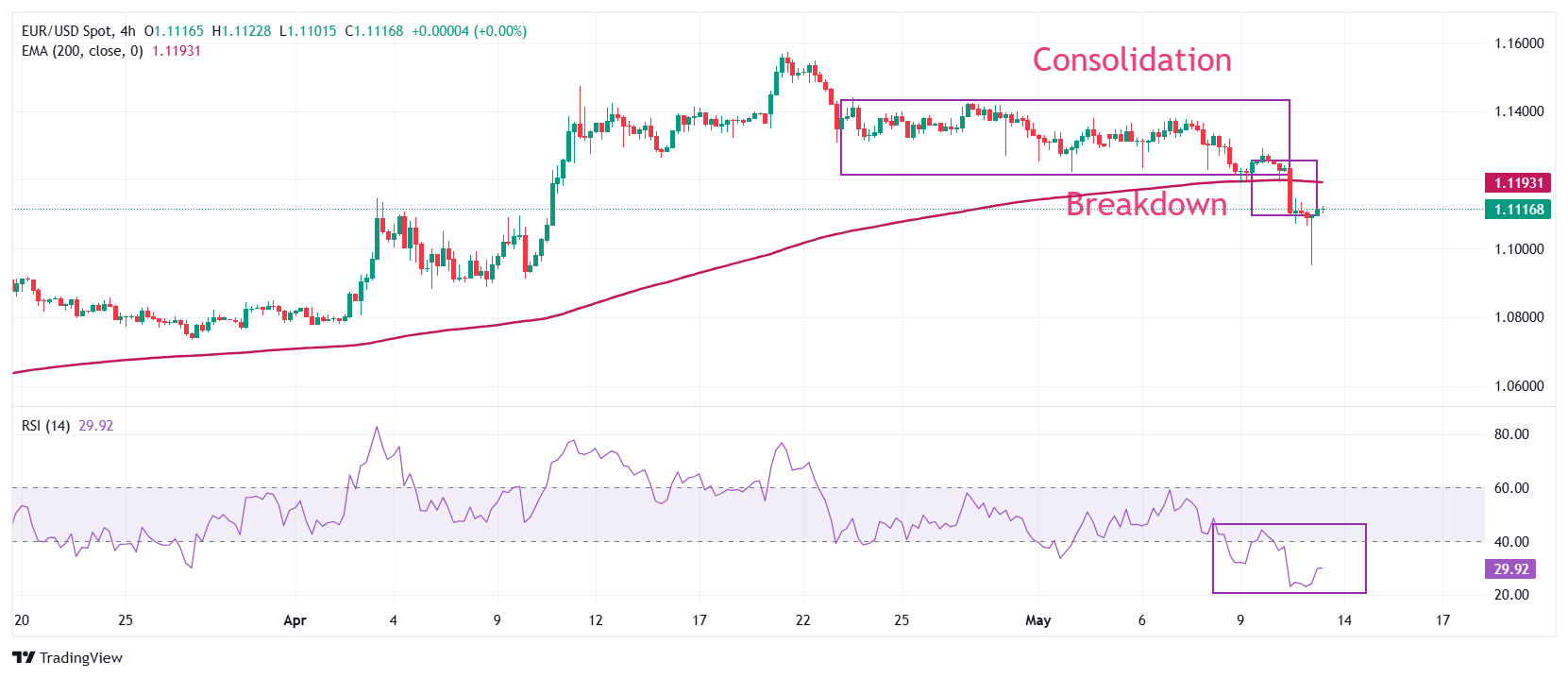EUR/USD trades with caution as US-China trade truce lifts US Dollar’s demand
- EUR/USD edges higher to near 1.1100 while a temporary US-China trade truce and the absence of EU-US trade talks keep the pair on the backfoot.
- Fed Goolsbee still warns of a US economic slowdown and high inflation.
- US CPI is expected to have grown steadily year-on-year.
EUR/USD trades cautiously near a month low around 1.1100 during European trading hours on Tuesday. The major currency pair struggles to gain ground as the outlook of the US Dollar (USD) has strengthened after the United States (US) and China agreed to avert an escalation in the trade war and reduce tariffs substantially on Monday.
At the time of writing, the US Dollar Index (DXY), which tracks the Greenback’s value against six major currencies, clings to the previous day’s gains around 101.60.
On Monday, Washington and Beijing lowered tariffs by 115% for 90 days after a two-day meeting in Geneva over the weekend, resulting in a decline in the additional levy to 10% on the US and 30% on China. The burden of the fentanyl levy of 20% on China remained intact, while Washington has assured that there have been “constructive discussions” to resolve it.
The announcement of a temporary truce resulted in a sharp upside in the US Dollar and a rally in US equity indices, which signals that investors have regained confidence in the US economic outlook. The imposition of significantly higher reciprocal tariffs by the US on China led to a substantial decline in the US Dollar and demand for US assets. Market experts and Federal Reserve (Fed) officials painted a grim picture of the US economy in the wake of the US-China trade war.
After the temporary US-China trade truce, Fed officials have become less fearful over the economic outlook. On Monday, Chicago Fed President Austan Goolsbee stated that the impact of the US-China tariff war will be lower than they had anticipated earlier. "It is definitely less impactful stagflationarily than the path they were on,” Goolsbee said, Reuters reported. However, he warned that fears of high inflation and economic slowdown are still intact. “Tariffs are still three to five times higher than what they were before, so it is going to have a stagflationary impulse on the economy. It’s going to make growth slower and make prices rise," Goolsbee said.
Daily digest market movers: EUR/USD edges up but outlook remains bearish
- EUR/USD ticks higher above 1.1100 on Tuesday as the US Dollar takes a breather after a strong rally on Monday. However, the outlook of the pair is becoming weak as the European Union (EU) and Canada seem to be the only major economies that have not reported any meaningful progress in trade discussions with the US since President Donald Trump's announcement of reciprocal tariffs.
- Additionally, the EU has prepared countermeasures if trade talks with the US don’t conclude positively, a move that could lead to trade tensions. On Thursday, the European Commission launched a public consultation paper that contained countermeasures on up to €95 billion of US imports if trade talks fail to deliver a satisfactory result for the bloc.
- Another factor behind the gloomy outlook of the pair is the solid European Central Bank (ECB) dovish bets. Traders have become increasingly confident that the ECB will cut interest rates again in the June meeting as officials have signaled that the disinflation trend is intact and price pressures will return to the 2% target by the year-end.
- On the economic front, the US Consumer Price Index (CPI) data for April will influence the EUR/USD pair, which will be published at 12:30 GMT. The CPI report is expected to show that inflationary pressures remain stable year-on-year. The headline and core CPI are estimated to have grown at a steady pace of 2.4% and 2.8%, respectively.
Technical Analysis: EUR/USD strives to gain ground near 1.1100

EUR/USD gains temporary ground below 1.1100 on Tuesday after a sharp sell-off the previous day. The pair plunged on Monday after a breakdown of the 1.1200-1.1440 range formed in the prior 20 trading days. The major currency pair extends its downside move below the 200-period Exponential Moving Average (EMA), which is around 1.1200, indicating a bearish trend.
The 14-period Relative Strength Index (RSI) slides below 40.00, suggesting that a fresh bearish momentum has been triggered.
Looking up, the April 28 high of 1.1425 will be the major resistance for the pair. Conversely, the March 27 low of 1.0733 will be a key support for the Euro bulls.

